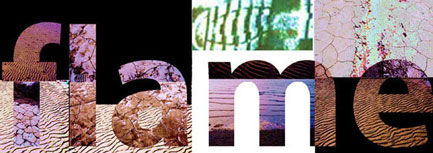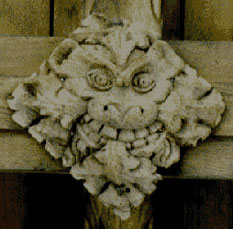

Co-editors: Seán Mac Mathúna • John Heathcote
Consulting editor: Themistocles Hoetis
Field Correspondent: Allen Houglande-mail: thefantompowa@fantompowa.org
|
|

The Green Man
on a Church Tilton on the Hill, England. The Legend of Herne There is
an old tale goes that Herne the Hunter, You have
heard of such a spirit, and well you know "The Merry Wives of Windsor", Act 4, Scene 4, William Shakespeare It is widely thought that Carnival first came to London when the Notting Hill Carnival was started back in the 1960's. However, there is evidence that Carnival in London has much older roots going back to the days when the Celtic population of London and the surrounding areas in pre-Saxon London (circa. 5th century AD), worshipped the Horned God or Green Man - the Pagan fertility God closely connected with Greenwich (the Green Village) and the legends of the Isle of Dogs. Cuckold's Point - connected with Stag worship and the Horned God ?I will argue in this essay that the first Carnival in London was with the Horn Fair which marched in carnival style from Cuckold's Point in what was then Bermondsey to Charlton until it ended almost 180 years ago. Although The London Encyclopedia, says "it's origins are uncertain"(1), this festival is almost certainly something that was carried forward from an older Celtic festival in distant times. Although the fair was stopped by the authorities in 1872, with the support of Greenwich Council, it has started again on an annual basis again in Charlton in Hornfair Park. There is only one other place l have been able to find in London which has this name and it's called Cuckold's Haven, which is on the River Roding near Barking in East London. For many years l have been intrigued as to why the Horn Fair started at Cuckold's Point in Rotherhite. It is directly opposite the new Canary wharf development off Rotherhithe Street in south London. As the starting point of the Horn Fair it must have had some early significance, whose meaning has now been lost. Maybe the start of the Fair here give's us a clue to it's origins: Perhaps the Isle of Dogs was a place where scared rituals dedicated to the Horned God were carried out before the participants crossed the Thames by boat - their arrival heralding the start of the Fair. According to some local tradition, the fair was started after King John seduced the wife of a local miller and, in recompense, gave her wronged husband all the land visible from Charlton to Rotherhithe. The miller's neighbours named the riverside boundary of his new land Cuckold's Point and established the annual Horn Fair (horns being the symbol of cuckoldry). This seems highly unlikely as this would have included both the royal palace in Greenwich and the naval dockyards in Deptford. If this miller was given all this land as the story claims then he would be a person who was very rich and as a result of becoming of the areas biggest landowners his identidy would be well known and recorded in local journals. Cuckold's Point may have some geomantric significance according to claims made by the London Psychogeographical Association. They looked into the the alignment of Canary Wharf, say it is aligned with St Paul's Cathedral and Cuckold's Point to the west, but that it also traverses the top of Greenwich peninsular to the east. It is clear that the term "cuckold" whilst linked with a jilted and impotent man, was also connected to the both the Horned God and the stag - both Pagan traditions which had strong beliefs in this area long before the arrival of Norman kings such as King John. In the medieval times in England, men whose wives are unfaithful to them were said to wear horns. Shakespeare made references to the cuckold, or horned man - "a man whose wife is having an affair with another man". I suspect there is more to the original story about the miller who had his wife seduced by King John. The site could have been where Celt's in London workshiped at the dawning of the new year at Samhain: Ancient Celtic religion cast the year as a contest between the gods of winter and summer for the favor of the goddess of the earth. The god of summer claimed victory at May Day, but at Samhain the god of winter, who was also lord of the dead, was victorious. Celts often depicted the god of winter with "cuckold" antlers which he shed each autumn like a stag. From The Celtic New Year According to E. Cobham Brewer (1810&endash;1897) and the Dictionary of Phrase and Fable (1898), the term "cuckold" is also cleary linked to stag, and thus, it is must be more of a coincidence that this area of the River Thames and London with all it's links to the Horned God has these connections: To wear the horns. To be a cuckold: In the rutting season, the stags associate with the fawns: one stag selects several females, who constitute his harem, till another stag comes who contests the prize with him. If beaten in the combat, he yields up his barem to the victor, and is without associates till he finds a stag feebler than himself, who is made to submit to similar terms. As stags are horned, and made cuckolds of by their fellows, the application is palpable. Thomas W. Gallant argues how the horn has been born a symbol both of sexual power as well as impotence: "In numerous peasant societies across the Mediterranean and elsewhere, anthropologists and social historians have repeatedly found the horn . . . to be employed as a powerful emblem of sexual impotence or power . . .To give a man "the horn" was to signify the sexual conquest of his wife, and thereby to expose the impotence of the husband and the power of the adulterer . . ." From Turning the Horns: Cultural Metaphors, Material Conditions, and the Peasant Language of Resistance in Ionian Islands (Greece) During the Nineteenth Century The Horn Fair in Deptford and CharltonAccording to Steve Wilson writing in his book Robin Hood: The Spirit of the Forest, Charlton village green was the site of a Pagan festival which became known as the Horn Fair, during which: "The Men would be dressed as women . . . all would wear horns, blow horns, carry horns, and at the fair, would buy trinkets carved from iron".(1) An account from 1700 indicates that The Horn Fair was already becoming a multicultural event. This describes the scene at New Dock, Deptford: Having past by a great number of these condescending mortals, we came to a field which led to the entrance of the Dock, about a stones cast on this side of which, were a parcel of East Indian Creoleians, lately come on shore, cooking in the open air, and English porter after the Indian manner . . . (2) When the procession arrived in Charlton from Bermondsey, the parade would march around the Church of St. Luke three times "before getting down to the serious business of having fun". St. Luke's feast day is on October 18th, and he is often depicted writing beside an Ox or Cow, whose horns are very prominent. The fair reached its heyday during the reign of Charles II (1660-1685), during which thousands of people visited Charlton &endash; presumably following the procession as it marched down through Deptford and up Blackheath Hill &endash; dressed as "King's, Queen's and Miller's", with horns on their heads. The site of fair in Charlton (now part of the grounds of Charlton House), was near a 17-acre iron-age fort, of which nothing now remains.(3) A smaller scaled down version of the Horn Fair is held every year in Charlton. Jack Cade's CavernThere are other connections with the Pagan fertility rites and worship of the Horned God. There is a cave known as Jack Cade's cavern underneath the site of a old stone circle at Maidenstone Hill on the edge of Blackheath Common, known today as The Point. Described as "of great antiquity and unknown use", it was carved out of chalk by tools made of antler, and it contains four large and three small chambers, with a well at its farthest end. The carving of the Horned God is just within it's entrance. The site was sealed up at the beginning of the century. One wonders why this cave was named after Cade. Did he worship there before marching onto London ? On a final note, a believe that South London's Horn Fair should be restored on its original route from Bermondsey to Charlton every May Day. It is an event that should be modeled on the Notting Hill Carnival, with Steel Bands, Samba Schools, Sound Systems, and dancers dressed like those in the Horn Dance in Abbots Bromley. It would give London a second Carnival and would keep alive the Horn Fair well into the present millennium. REFERENCES 1 The London Encyclopedia, Edited by Ben Weinrub and Christopher Hibbert, Paperback, London, England, 1983, p140. 2 Longest Journey: A History of Black Lewisham. Joan Anim-Addo. Deptford Forum Publishing Ltd, London SE 14, 1995. p37 3 Robin Hood: The Spirit of The Forest, Steve Wilson, Neptune Press, London, England, 1993, p22. © 1997 |
|
|
|